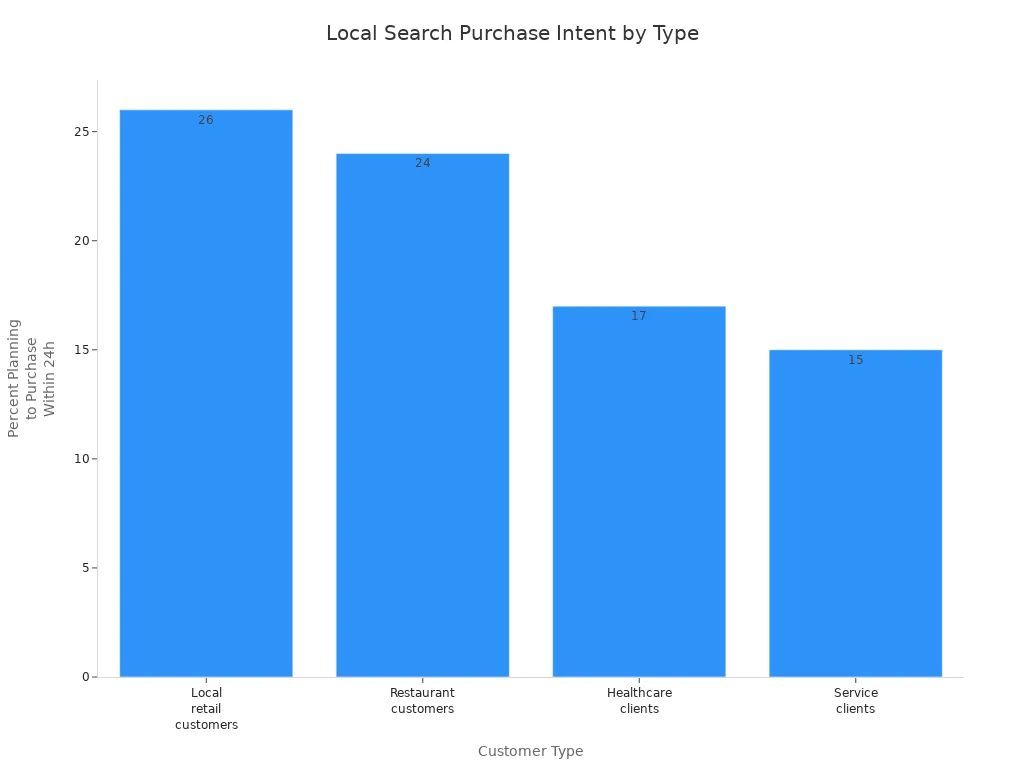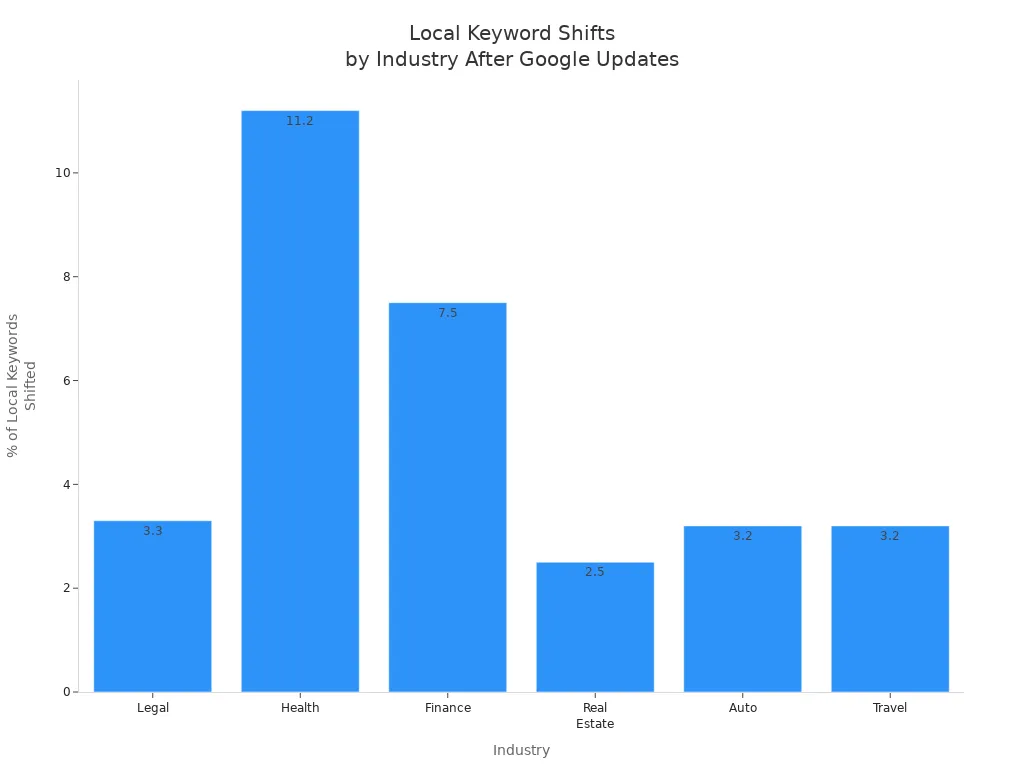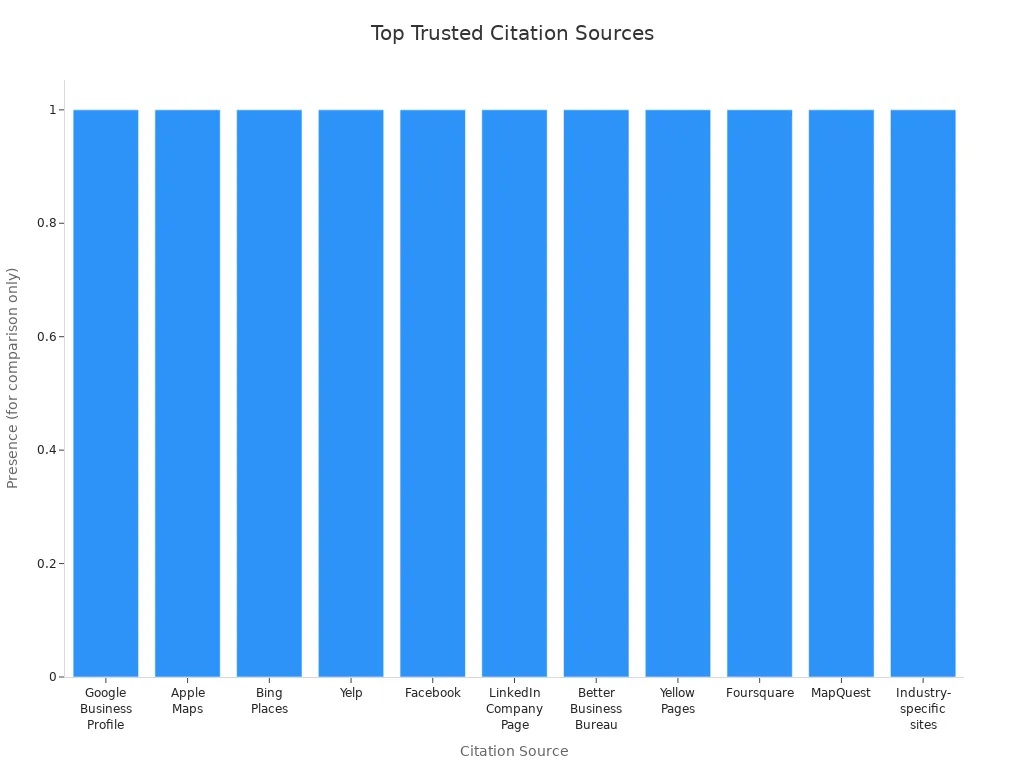Top Tactics for Local SEO Competition Success

Winning in Local SEO Competition requires smart moves and quick action. Did you know that 18% of local mobile searches lead to a purchase within just 24 hours? Check out the chart below to see how different customer types plan to buy after searching locally:

Think about your own neighborhood. Your business can stand out with the right seo steps. You will find simple, step-by-step tactics here to help you outsmart competitors nearby.
Local SEO Competition
Why It Matters
You face local SEO competition every day, whether you run a food truck or a retail shop. Local search results decide which businesses customers see first when they search for services nearby. Nearly 80% of local mobile searches lead to an in-store visit within one day. This means your spot in local search results can bring more foot traffic and online conversions. Local SEO competition is fierce in big cities. For example, over 500 businesses may compete for a keyword like "dentist Chicago." In small towns, you might only compete with 5 to 10 local competitors for the same keyword. You can rank at the top faster in smaller markets, sometimes within 60-90 days.
Local SEO helps you stand out. It improves your visibility, targets customers in your area, and builds trust through reviews and accurate business information. You connect with your community and become a reliable choice. Here are the most common types of businesses competing in local SEO competition:
- Service area businesses such as plumbers
- Fast food franchises
- Local service providers, including home-based businesses like in-home daycare
- Brick-and-mortar retail shops
- Hybrid businesses like restaurants offering dine-in and delivery
- Mobile businesses such as food trucks
Local SEO competition impacts your local search rankings and your ability to attract new customers. You need to optimize your Google My Business profile, keep your Name, Address, and Phone number consistent, and encourage positive reviews.
Key Challenges
You will face several challenges in local SEO competition. The biggest issues include:
- Neglecting location in your SEO strategy, especially if you have more than one location.
- Managing local listings accurately and consistently across all platforms.
- Competing with both local competitors and larger national chains with strong online authority.
Other common challenges:
- Limited reach and low brand visibility in your area
- Heavy reliance on Google Business Profile for traffic and trust
- Inconsistent NAP details across directories
- Fewer online reviews and backlinks compared to national competitors
- Lack of expertise in technical and strategic local SEO tasks
- Limited resources such as time, budget, and marketing staff
Google updates its algorithm 500 to 600 times each year. These changes can shift your position in local search results. The chart below shows how different industries experience shifts in local keywords after Google algorithm updates:

You must monitor your local search rankings and adapt your SEO strategy to stay ahead in local SEO competition.
Analyze Local SEO Competition
Understanding how to analyze local SEO competition gives you a clear path to outrank other businesses in your area. You need to know who your local competitors are, what tools help you compare your performance, and how to audit their Google Business Profiles. This process helps you spot gaps and find new opportunities to improve your online presence.
Identify Local Competitors
You must first identify the businesses that compete with you for top spots in Google Maps, the local pack, and organic search results. Start by searching your main keywords along with your location. For example, if you run a bakery in Austin, search for "bakery Austin" or "best cupcakes Austin." Look at the local pack—the top three businesses with map pins. These are your direct competitors.
Tip: Try different keyword combinations to uncover businesses targeting specific niches in your industry.
Follow these steps to identify your main competitors:
- Check which businesses appear in the local pack and organic results for your target keywords.
- Search for similar services or products on Google Maps. Note the businesses with the highest ranking Google Business Profiles.
- Use competitor analysis tools like SEOptimer or Semrush to find websites ranking for the same keywords.
- Explore online directories such as Yelp, TripAdvisor, and industry-specific directories filtered by category and location.
- Review social media platforms like Facebook to find businesses with strong local presence, even if they do not rank high on Google.
- Focus on the 10-15 most relevant competitors who show up across multiple platforms.
You can also use keyword research tools to pinpoint local competitors. Enter a competitor’s URL and location into tools like WordStream or Google Keyword Planner. These tools reveal the keywords your competitors target and help you understand their SEO strategies. Look for keyword gaps and opportunities to add city or neighborhood names to your own keywords. This anchors your business in local search results and boosts your local SEO analysis.
Use Competitor Analysis Tools
Competitor analysis tools make it easier to analyze local SEO competition. These tools show you how your business compares to others in your area. They track keyword rankings, backlinks, and traffic trends. Here is a table of popular tools and their key features:
| Tool | Key Features Relevant to Local SEO | Purpose/Benefit for Local SEO Competitor Analysis |
|---|---|---|
| BrightLocal | Local Citation Tracker, Local Search Grid, Google Business Profile Audit | Tracks local citations, monitors local rankings, audits local SEO factors |
| Semrush | Keyword Gap Analysis, Backlink Analytics, Traffic Insights, Advertising Research | Provides comprehensive keyword and backlink data, tracks competitor SERP movements |
| Ahrefs | Site Explorer, Keyword Explorer, Content Explorer, Rank Tracker | Specializes in backlink data and link-building opportunities |
| AgencyAnalytics | Competitor Rank Tracking, SEO Benchmarks, Automated SEO Reports, Integrations with Semrush and Ahrefs | Integrates multiple SEO tools for streamlined rank tracking and benchmarking |
You can also use Local Falcon to visualize competitor rankings on a map grid. Local Falcon creates a color-coded heatmap that shows where your business and competitors rank for any keyword across your service area. The grid highlights areas where you dominate and spots where you need improvement. You can compare your Share of Local Voice with others and see exactly where you stand in local SEO competition.
Note: Using these tools helps you monitor changes in competitor rankings and adapt your strategy quickly.
Audit Google Business Profiles
A thorough Google Business Profile audit gives you insight into what makes your competitors successful. Start by identifying the top 3-5 local competitors from your earlier research. Then, compare their business information, photos, reviews, and local search rankings side by side.
Follow this checklist for a complete audit:
- Review the completeness and accuracy of each competitor’s business information.
- Compare the quality and quantity of photos and videos. Look for visual appeal and professionalism.
- Analyze review count, average rating, and the sentiment of customer feedback. Check how owners respond to reviews.
- Assess the frequency and engagement of Google Posts. Note how often they post and how customers interact.
- Check Google Q&A for accuracy, responsiveness, and any unanswered questions.
- Use tools like BrightLocal, Moz Local, Whitespark, and Google Business Profile Insights to support your audit and compare local search visibility.
- Present your findings in a simple report with actionable recommendations.
Do not forget to review your competitors’ websites and social media presence. Social media boosts website traffic and signals to search engines that your content is valuable. Active social profiles increase brand visibility, generate backlinks, and improve your online presence. Social media engagement, such as reviews and check-ins, also helps your business rank higher in local SEO competition.
Remember: A strong online presence across Google Business Profiles, websites, and social media gives you an edge in local SEO competitor analysis.
Optimize Google My Business Listing

Claim and Verify
Claiming and verifying your google my business listing is the first step to building a strong online presence. Many businesses miss out on local customers because they have not claimed their listing. The table below shows how many businesses have taken this important step:
| Source | Percentage of Businesses Claimed/Verified | Notes |
|---|---|---|
| Local Marketing Institute | 44% | Percentage of local retailers claimed |
| Bill Hartzer (via Mike Blumenthal) | 68% | Sample of 10,000 US small/medium businesses claimed |
| Birdeye.com | 64% | Percentage of businesses verified |
You should claim your business on both Google and Bing Places. Make sure you use your real business address and follow all guidelines. Many owners make mistakes during verification. Common problems include using P.O. boxes, not matching business names, or skipping important steps. Always check that your information matches your documents and that your business has clear signage. If you work from home, set up your profile as a Service Area Business.
Enhance Profile
After you claim your google business profile, you need to make it stand out. Complete every section with accurate details. Add a clear business description with important keywords, but do not overdo it. Choose the right categories for your services. Upload high-quality photos often. Listings with more photos get more clicks and calls. In fact, profiles with over 100 photos see much higher engagement and are seen as more trustworthy. Keep your business hours up to date, especially during holidays. Accurate hours help customers know when to visit and can increase calls by up to 94%. Encourage customers to leave reviews and always reply to them. Use Google Posts to share news, offers, or events. These steps help boost your online presence and improve your ranking in local searches.
Consistent NAP
Your Name, Address, and Phone number (NAP) must be the same everywhere online. Inconsistent NAP confuses search engines and customers. This can lower your ranking and hurt your online presence. Customers may find the wrong address or phone number, leading to lost sales. A study found that 68% of people stop using a business if they find incorrect contact details. To keep your NAP consistent, update your details on your website, social media, and all directories. Use tools like Moz Local or BrightLocal to track and fix any mistakes. Set reminders to check your listings every year. Always update your NAP if you move or change your business name. This helps search engines trust your business and keeps customers coming back.
On-Page SEO Tactics
Local Keywords
You need to choose the right local keywords to improve your local search rankings. Start by using Google Keyword Planner to find local search terms that match your area. SEMrush helps you see which keywords your competitors use, giving you new ideas. Focus on keywords that mention your city or neighborhood. These words are often less competitive and help you show up in local searches. Place your local keywords in your page titles, descriptions, and main content. This makes your site more visible to people nearby. Check your keyword performance often. Adjust your strategy if you see changes in traffic or rankings.
Tip: Make a list of your top local keywords and update it every month. This keeps your seo fresh and effective.
Landing Pages
Landing pages designed for local audiences can boost your conversion rates. Create a separate page for each location you serve. Use language and offers that fit each area. Add testimonials from local customers to build trust. Show pictures of local landmarks or events to connect with visitors. Include a map and directions so people can find you easily. Make sure your forms are simple and quick to fill out. Fast load times and mobile-friendly design help keep visitors on your page. When you use local keywords on these pages, you increase your chances of ranking higher in local search results.
- Write headlines that speak to local needs.
- Use strong subheadlines to highlight benefits.
- Make your call-to-action buttons stand out.
- Offer guides or free consultations to get contact details.
- Show before-and-after photos or videos.
- Add customer reviews with names and star ratings.
Meta Tags
Meta tags play a big role in local search visibility. Your title tags and meta descriptions should include local keywords and your business location. This helps search engines show your site to people searching for services nearby. Well-written meta tags can increase your click-through rates, which may improve your local search rankings. Update your meta tags regularly to keep them relevant. You can also use local business schema markup to help search engines understand your business better. Although meta keywords are not as important now, keeping your meta tags optimized still helps your seo.
Note: Check your meta tags every few months to make sure they match your current local keywords and business details.
Citations and Backlinks

Find Citation Sources
You need to list your business on trusted platforms to build strong local authority. Search engines look for local citation sources that confirm your business details. The most trusted sources include Google Business Profile, Yelp, Bing Places, Apple Maps, and Facebook. These sites check your information and help you show up in local searches. You should also add your business to LinkedIn, Better Business Bureau, Yellow Pages, Foursquare, MapQuest, and industry-specific directories like Angi or Houzz. Each platform helps search engines verify your business and location.
| Citation Source | Reason for Trust and Importance in Local SEO |
|---|---|
| Google Business Profile | Most important listing; enables map visibility and local reviews; foundational for local SEO rankings. |
| Apple Maps | Key for iPhone users; integrates with Siri for voice search; important for mobile visibility. |
| Bing Places | Important for desktop and Windows users; Microsoft's counterpart to Google Business Profile. |
| Yelp | High authority, especially for service businesses; integrates with Apple Maps; strong review platform. |
| Acts as both citation and social profile; supports customer engagement and reviews. | |
| LinkedIn Company Page | Trusted by search engines; ideal for B2B visibility. |
| Better Business Bureau | Recognized trust signal, especially in regulated industries. |
| Yellow Pages | Legacy citation source still valued by search engines. |
| Foursquare | Data powers other platforms despite lower user adoption. |
| MapQuest | Provides directory listings and map visibility for GPS services. |
| Industry-specific sites | Examples include Angi, Houzz, Thumbtack, which are niche directories relevant to specific business types. |
Search engines trust these sources because they use strong data checks and connect with maps and voice search. You build local authority when your business appears on these platforms.

Earn Local Backlinks
You can boost your local authority by earning backlinks from other local websites. Write blog posts about your community or local events. Local businesses and bloggers may link to your site if you share helpful guides or resources. Partner with other local brands for giveaways or sponsor a charity event. These actions help you get listed on community calendars and local blogs. Offer to update outdated local pages and ask for a link in return. Use SEO tools like Ahrefs or SEMrush to track your backlinks and see which ones help your rankings. Build relationships with partners, vendors, and clients to find more backlink opportunities. Stay patient and keep working on these strategies. High-quality local backlinks take time but make your business stronger in local searches.
Tip: Focus on real connections and valuable content. Avoid sending cold emails or using copy-paste outreach. Genuine relationships lead to lasting backlinks.
Clean Up Citations
You must keep your local citation details accurate and consistent. Search engines check your business name, address, and phone number (NAP) across all platforms. If you have duplicate listings or mismatched information, search engines may not give you full credit. This can lower your local search rankings and confuse customers. Regularly audit your citations and fix any errors. Moz found that correct citations are one of the top three ranking factors for local SEO. Cleaning up your citations helps search engines trust your business and improves your online reputation. Make sure your NAP matches everywhere, including your website, social media, and all directories. This builds trust and helps you rank higher in local searches.
Note: Accurate citations signal reliability to search engines and customers. Consistency leads to better rankings and more trust.
Reviews and Reputation
Get Positive Reviews
You build trust with local customers when you collect positive reviews. Many people read reviews before they visit a business. Almost half of consumers trust online reviews as much as personal recommendations from family and friends. In the business world, 68% of decision-makers rely on reviews when choosing products or services. You can ask satisfied customers to leave feedback after a purchase or service. Use simple requests in person, by email, or through text messages. Offer a small thank-you, such as a discount or entry into a giveaway, to encourage more reviews. Positive reviews help your business stand out in local searches and strengthen your local customer base.
Tip: Remind customers that their honest feedback helps other local customers make smart choices.
Respond to Feedback
You improve your reputation when you reply to reviews quickly. Most businesses respond within a few days to a week. Over half of customers expect a reply to negative reviews within one week, and about one-third want a response in three days or less. When you answer reviews with a personal message, customers feel heard and valued. Timely replies can increase customer advocacy by 16%. Ignoring complaints may cause a 37% drop in customer support. Responding to reviews can boost your review count by 12% and raise your average rating. One negative review can cost you up to 30 potential customers, which may mean thousands of dollars lost each year. You protect your business by addressing feedback and showing you care about local customers. Quick responses also help your seo by building trust with search engines.
Reputation Tools
You can use reputation management tools to track and improve your online image. These tools help you collect reviews, reply faster, and analyze feedback. The table below shows popular options for local businesses:
| Tool | Features & Benefits | Local Business Effectiveness |
|---|---|---|
| HiFiveStar | AI-powered auto-replies, unlimited review requests, real-time sentiment analysis, easy to use, 24/7 support. | Highly effective for local businesses due to ease of use and affordability. |
| MARA AI | Personalized review responses, review inbox, analytics, brand voice customization, smart snippets. | Great for saving time and personalizing replies for local customers. |
| Podium | Centralized messaging, review management, payments, automation, integration with business tools. | Useful for automating review requests and engaging your local customer base. |
| Birdeye | AI sentiment analysis, unified dashboard, messaging, survey tools. | Better for businesses with multiple locations. |
| ReviewTrackers | Collects reviews from 100+ sources, alerts, detailed reports. | Suitable for local businesses but may need time to learn. |
You choose a tool that fits your needs and budget. Many tools offer automation and easy dashboards, making it simple to manage your reputation and connect with local customers.
Hyperlocal Content
Local Content Ideas
You can attract more local customers by creating content that speaks directly to your neighborhood. Write blog posts about local landmarks or popular places in your area. Share guides that help people find the best spots for shopping or dining. You can interview local business owners and feature their stories. Use photos of your storefront and nearby streets to give your website a local feel. Try making short videos that show your team working or highlight products that local people love.
Tip: Use questions from your community as topics for your next article. This shows your local focus and builds trust.
Community Engagement
You build strong relationships when you get involved with your community. Respond to comments on your social media pages. Ask for feedback from local customers and share their reviews on your website. Support local charities or sponsor a youth sports team. You can host a contest where people submit photos of your products in local settings.
- Join local Facebook groups and answer questions about your services.
- Partner with schools or libraries for educational workshops.
- Share news about community projects or improvements.
A table can help you track your engagement activities:
| Activity | Goal | Result |
|---|---|---|
| Sponsor local event | Increase awareness | More followers |
| Host contest | Boost engagement | More shares |
| Support charity | Build goodwill | Positive press |
Events
You drive local traffic by promoting events that matter to your area. Announce sales, grand openings, or holiday specials on your website and social media. Create event pages with clear details, dates, and directions. Invite local influencers to attend and share their experiences.
Note: Posting about local events helps you show up in search results when people look for things to do nearby.
You can also list your events on community calendars and local news sites. This increases your visibility and brings more people to your business. Always follow up after an event by sharing photos and thanking attendees.
Monitor Local Competitors
Track Changes
You need to keep an eye on your local competitors if you want to stay ahead. Watch for changes in their Google Business Profiles, such as new photos, updated business hours, or fresh posts. When a competitor gets more reviews or changes their categories, it can affect your own ranking. If you notice a drop in your sales or website traffic, check if a competitor has launched a new promotion or improved their profile. Quick competitor analysis helps you spot these shifts early. You can then respond before you lose customers.
Tip: Set a weekly reminder to review your top competitors’ profiles and websites. This habit helps you catch updates right away.
Adapt Strategies
You must adjust your local SEO strategy when you see competitors making changes. For example, if a competitor starts posting more often or collects more reviews, you should match or exceed their efforts. Analyze their content, keywords, and promotions. Use competitor analysis to find gaps in your own approach. If you see a new business enter the market, study their tactics and adapt quickly. This keeps your business visible and competitive. Ongoing monitoring lets you refine your strategy in real time, so you can respond to market changes and customer needs.
Use Monitoring Tools
You can use tools to make competitor tracking easier. Tools like BrightLocal, Semrush, and Local Falcon help you monitor local search rankings, review counts, and profile updates. These tools show you how your competitors perform over time. For multi-location brands, monitoring tools are even more important. They help you track changes across different cities or regions. You can compare performance and spot trends faster. Regular use of these tools ensures you never miss important updates from your competitors.
Note: Continuous monitoring and competitor analysis help you find new opportunities and protect your market share.
You now have the top tactics for winning local SEO competition.
- Analyze your competitors and optimize your Google Business Profile.
- Use local keywords and build strong citations.
- Collect reviews and create hyperlocal content.
- Monitor your competitors and adapt your strategy.
Stay proactive. Track your results and adjust your approach as needed. Share your experiences with others or ask for expert advice if you need help.
FAQ
What is the fastest way to improve your local SEO ranking?
You should update your Google Business Profile with accurate information and new photos. Ask customers for reviews. Use local keywords on your website. Check your NAP details for consistency across all platforms.
How often should you audit your local SEO competitors?
You need to audit your competitors every month. Regular checks help you spot changes in their profiles, reviews, and rankings. Quick action keeps your business ahead in local search results.
Do reviews really affect your local search ranking?
Yes, reviews play a big role. Positive reviews boost your ranking and build trust with customers. Responding to reviews shows you care. More reviews mean more visibility in local searches.
Tip: Ask happy customers for feedback after each visit.
Which tools help you track local SEO performance?
You can use BrightLocal, Semrush, and Local Falcon. These tools track rankings, reviews, and competitor changes. They show you where your business stands and help you find new opportunities.
- BrightLocal: Local rankings and citations
- Semrush: Keyword and backlink analysis
- Local Falcon: Map grid rankings
See Also
Effective Strategies To Improve Your Website Search Rankings
How To Use SEO Writing Tools To Enhance Website Ranking
Winning SEO Content Distribution Techniques For Digital Marketing

